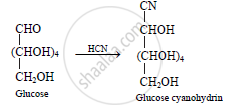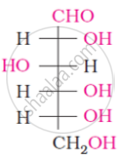Advertisements
Advertisements
Question
What happens when glucose is treated with hydrogen cyanide?
Solution
Action of hydrogen cyanide (HCN) on glucose: The reaction of glucose with
hydrogen cyanide gives cyanohydrin. This indicates the presence of carbonyl group.

APPEARS IN
RELATED QUESTIONS
Draw the simple Fisher projection formulae of D - (+) - glucose and D - (-) - fructose
Enumerate the reactions of D-glucose which cannot be explained by its open chain structure.
Maltose is a
(a) Polysaccharide
(b) Disaccharide
(c) Trisaccharide
(d) Monosaccharide
Write the product when D-glucose reacts with conc. HNO3.
Glucose on reaction with HI gives n-hexane. What does it suggest about the structure of glucose?
Fill in the blanks by choosing the appropriate word/words from those given in the brackets:
(iodoform, acetaldehyde, positive, greater, acidic, acetone, disaccharide, negative, increases, glucose, decreases, chloroform, polysaccharide, lactose, lesser, basic, cationic hydrolysis, anionic hydrolysis)
Sucrose is a _________ and yields upon hydrolysis, a mixture of ________ and fructose.
Write the reactions involved when D-glucose is treated with the following reagent:
H2N-OH
The following compound can be called as:

The spatial arrangement of the given molecule is denoted by:

What is the most abundant organic compound on earth?
Acetylation of glucose yields ____________.
Which of the following statements is incorrect regarding glucose?
The symbols D and L represents ____________.
Glucose does not react with ____________.
Which of the following properties of glucose cannot be explained by its open chain structure?
(i) Glucose does not form hydrogen sulphite with NaHSO3.
(ii) On oxidation with HNO3 glucose gives saccharic acid.
(iii) Glucose is found to exist in two different crystalline forms which are named as α and β.
Which is the least stable form of glucose?
A solution of D-glucose in water rotates the plane polarised light ____________.
The number of chiral carbon atoms present in cyclic structure α-D(+) glucose:
Which one is correct?
How will you distinguish 1° and 2° hydroxyl groups present in glucose? Explain with reactions.
Write the reactions of D-glucose which can’t be explained by its open-chain structure. How can cyclic structure of glucose explain these reactions?
On the basis of which evidences D-glucose was assigned the following structure?
\[\begin{array}{cc}
\ce{CHO}\\
|\phantom{....}\\
\phantom{..}\ce{(CHOH)4}\\
|\phantom{....}\\
\phantom{..}\ce{CH2OH}
\end{array}\]
What happens when D-glucose is treated with the following reagent?
HI
Account for the following:
What happens when D – glucose is treated with the following reagents
HNO3
When D-glucose reacts with HI, it forms ______.
Give the reaction of glucose with hydrogen cyanide. Presence of which group is confirmed by this reaction?
Give a reason for the following observations:
Penta-acetate of glucose does not react with hydroxylamine.
